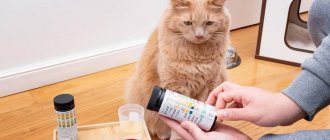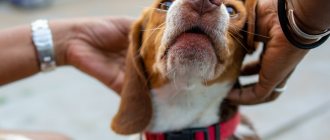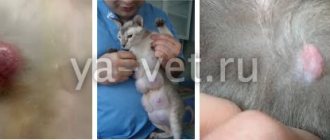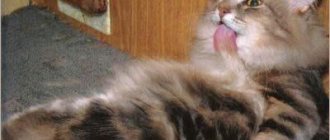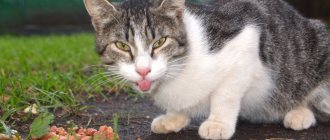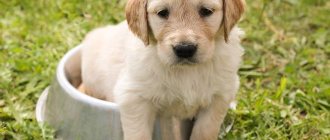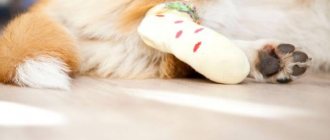Pet feces are not something that the owner is used to looking closely at. However, it can sometimes be used to judge the health status of the pet. If the stool looks like a soft, oblong substance that is dark brown in color, it is safe to say that your pet is normal. By consistency, shape and color you can judge the internal problems of the body. The most dangerous signal is the appearance of blood in the animal’s stool. If you notice that your pet is pooping blood, immediately take him to a specialist. Such a symptom does not mean anything good.
What does blood look like in a dog's stool?
If your dog has bloody stools, the possible cause can be determined by the intensity of the color. A bright scarlet hue indicates the absence of fermentation and curdling. In this case, the discharge occurs directly from the anus, rectum or colon.
If bleeding affects the upper intestines, stomach or esophagus, the blood reacts with local enzymes. As a result, the scarlet shade changes to brown or black. Due to coagulation, feces come out mixed with small brown grains.
What is the danger of internal bleeding
Loss of blood leads to the development of anemia in the animal, and due to low blood pressure and constant weakness, the dog is less able to tolerate any stress on the body and becomes drowsy. Without proper care and treatment, your pet may develop problems with the functioning of its organs. The worst-case scenario is the death of your pet.
The cause of death can be too much blood loss, dehydration, intoxication and exhaustion. In all these cases, you will need the help of a specialist.
Possible reasons
Most often, bloody diarrhea or hard stool is due to damage to the intestinal mucosa. It can be caused by internal injuries, diseases or other reasons.
Internal injuries
If the intestines are damaged, the animal defecates normally without suffering from diarrhea or constipation. Bleeding can be suspected only by the color of the stool: it becomes dark brown or completely black. Injuries are caused by sharp bones that scratch the intestinal wall, or other foreign objects (for example, a chewed hard toy).
If the injury is caused to the abdominal organs, then the dog not only develops stool with black blood, but also bloody-black vomit. The animal experiences excruciating pain and may die not only due to excessive blood loss, but also due to painful shock.
Digestive tract diseases
With dysbacteriosis, the dog appears in feces streaked with blood and mucus. Due to an increase in pathogenic bacteria and an imbalance in the internal balance, inflammation occurs in the large intestine. In the acute form, increased bleeding is observed.
Another possible cause is hemorrhagic gastroenteritis. This inflammatory disease affects not only the intestines, but also the gastric mucosa. The main symptoms are prolonged vomiting and diarrhea. Those at risk include shelties, dachshunds, miniature schnauzers and all poodles except the standard poodle.
Bloody streaks in the stool or direct bleeding from the anus are characteristic of neoplasms. Malignant tumors cause more severe consequences, since during metastasis they affect most of the cells.
Hemorrhoids are least often diagnosed in four-legged pets. In this case, the bloody discharge is scarlet. A similar disease occurs in animals that often suffer from constipation. The risk group includes breeds prone to gaining excess weight: Pekingese, St. Bernards, pugs, Rottweilers, French bulldogs.
Parasitoses
Bleeding is typical for ascariasis, uncinariasis and hookworm infection. The worms that cause these diseases injure the mucous membranes, causing internal bleeding. The risk group includes all animals that have not undergone timely treatment with anthelmintic drugs.
Infections
Parvovirus enteritis is especially dangerous for puppies. This infection is accompanied by vomiting and watery diarrhea with a very strong odor. Without timely assistance, the animal dies within 3-4 days.
If an unvaccinated dog has runny, mucous stool with blood in it and has developed photophobia, check it for the intestinal form of distemper. The most striking signs of this infection include darkening of the enamel, the formation of a white coating on the tongue and the appearance of a sour body odor. With a lightning-fast course, the disease can kill an animal in just a day.
The cause may also be an atypical form of rabies, which excludes the sudden mood swings characteristic of the violent form. It develops over 3-6 months, and its symptoms resemble gastroenteritis.
Other reasons
Separately, it is worth noting the long-term use of non-steroidal anti-inflammatory drugs (NSAIDs). If your pet is taking NSAIDs, consult your veterinarian about a possible replacement. An incorrectly selected drug can lead to ulceration of the gastric mucosa.
Your dog can also be poisoned by poisons or chemicals by ingesting rat poison or floor cleaner. In case of acute intoxication, bloody vomiting and convulsions may occur, as well as loss of coordination and temperature fluctuations. If you do not have time to get to the clinic in 2 hours, then the effect of the poison will have to be neutralized yourself with the help of an antidote.
Diagnostics
Various bleeding in the digestive tract sooner or later lead to the onset of anemia. As a result of anemia, the trophism of tissue structures is disrupted, and oxygen ceases to flow to the organs in the required volume. The most important diagnostic method is a general blood test of the dog. In addition, the veterinarian prescribes a number of other tests:
- analysis of excrement for the presence of helminthic infestations;
- biochemical analysis of blood and feces (to exclude infectious pathology);
- study of the functional characteristics of blood clotting;
- ultrasound diagnostics of the abdominal organs;
- X-ray examination;
- gastroduodenoscopy;
- rectocolonoscopy.
Associated symptoms indicating illness
The formation of red pigments in the stool is possible when eating red foods or in female dogs during heat. In these cases, treatment is not required, since the color of the feces normalizes on its own.
More serious causes will be indicated by accompanying symptoms:
- lethargy and loss of appetite;
- prolonged diarrhea and vomiting;
- increase or decrease in temperature;
- increased breathing;
- the appearance of a cough or discharge from the nose or eyes;
- acrid smell of feces and the formation of mucus in them;
- abdominal pain;
- paleness of mucous membranes and dry skin;
- sudden weight loss.
In addition to puppies, small breed dogs are also at risk. They are difficult to tolerate dehydration, so in case of any disturbances in the gastrointestinal tract, they must be taken to the clinic within 24 hours. A later diagnosis may not be possible due to sudden death.
Accurate diagnosis in a veterinary clinic
The veterinarian will tell you what to do to eliminate blood in the dog’s stool only after finding out the cause. In addition to collecting anamnesis and examining the four-legged patient, you will need:
- examine blood, stool and urine tests to confirm or deny the presence of infection;
- do an ultrasound to determine the presence of polyps or other formations in the gastrointestinal tract;
- conduct x-rays and endoscopy to assess the condition of the mucous membranes.
Depending on the diagnosis, the dog may require medication or surgical treatment. It is not recommended to use drugs before diagnosis, but exceptions are allowed in cases of severe and painful symptoms.
The owner's first actions
Before visiting the veterinarian, you can try to stop the bleeding with folk remedies. Nettle or chamomile decoction is suitable for this. A decoction of oak bark will help cope with bacteria.
The consequences of intoxication can be eliminated with sorbents: activated carbon, Enterosgel or Polysorb. In addition to flushing out toxins, they can firm up the stool. Rice water will also cope with this.
To reduce the load on the gastrointestinal tract, put your pet on a starvation diet. If you maintain your appetite, eat soft and light foods. If the animal eats dry food, soak the granules with water.
How is the treatment carried out?
If foreign objects are found that have damaged internal organs, they are removed surgically. Surgery may also be required to remove tumors or open ulcers caused by inflammation.
In all other cases, treating blood in a dog’s stool involves taking medications. To restore lost strength, the four-legged patient is given a temporary diet that excludes infrequent feeding and heavy food.
Medications
The choice of drug is determined by the diagnosis. For helminthiasis, anthelmintic drugs (Dironet, Drontal, Kanikvantel) are used, for parvovirus enteritis - hyperimmune serums, and for hemorrhoids - hemostatic suppositories and venotonic drugs. A four-legged patient may also need:
- antispasmodics
(Papaverine, No-Shpa), which relieve painful spasms and normalize peristalsis;
- antibiotics
(Sulgin, Tylosin, Diarkan), directly affecting the pathogen;
- probiotics
(Lactoferon, Lactobifadol), normalizing intestinal microflora;
- sorbents
(Enterosgel, Smecta), which remove toxins and have an antidiarrheal effect;
- antiemetics
(Cerucal) and hemostatic drugs (Vikasol, Dicynon);
- immunomodulators
(Gamavit) and vitamins that stimulate the immune system.
To eliminate the effects of dehydration, droppers with infusion solutions are placed. If there is severe blood loss, a transfusion is possible.
Folk remedies
The use of folk remedies is acceptable as an auxiliary treatment, but only under the supervision of a veterinarian. Soldering with vodka and other popular methods can cause the death of an animal due to severe poisoning.
For faster healing of wounds and relief of inflammation, use chamomile decoction. If your pet has been diagnosed with hemorrhoids, and cracks are found in the anus, then sea buckthorn oil will be useful for their healing.
Care and feeding
When caring for a patient, you will have to take care not only of his comfort, but also of gentle nutrition. The therapeutic diet must be followed for 2-3 weeks even if the pet’s condition is normalized.
On the first day, a fasting diet is recommended. Only water remains freely available. If the dog refuses to drink, then he is forced to drink through a syringe. If vomiting occurs, it is recommended to give an ice cube to lick. This will prevent new attacks and protect against dehydration.
If the condition improves, on the second day slimy porridges made from rice and oats are administered. Later, a small amount of boiled chopped chicken and fermented milk products are added. Fresh vegetables and fruits are returned no earlier than 2 weeks. The timing of the return of dog bones is discussed with your veterinarian.
Food is given often, but in small portions. All dishes are served fresh and warm. If you do not have the opportunity to cook so often, use industrial medicinal food designed for animals with gastrointestinal diseases.
Treatment of bleeding from the anus
Only a veterinarian can diagnose the cause of blood in feces.
Your pet should be examined immediately after red discharge appears in the stool.
Antiviral antibiotics are used to treat diseases caused by infections. After such antibiotics, it is recommended to take a course of the drug, which will restore the natural intestinal microflora and strengthen the dog’s immunity.
Getting rid of worms will be ensured by means that kill parasites inside the intestines. Your veterinarian will help you prescribe anthelmintic medications correctly.
If the body becomes dehydrated, it is necessary to give the dog access to fresh water and immediately contact a veterinary clinic.
Having identified the disease that caused the bleeding, there is a chance to cure the pet, but treatment should only occur under the supervision of a veterinarian.
Amateur activities and treatment with traditional methods can be fraught with consequences and cost the dog’s life.
There is a diet for a pet that is undergoing treatment. It is necessary to exclude hard bones from the dog’s diet, which can injure the stomach; products containing high acidity; food that can irritate the walls of the stomach or intestines.
Therapy for rectal bleeding involves a high-quality and balanced diet
